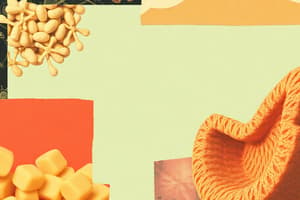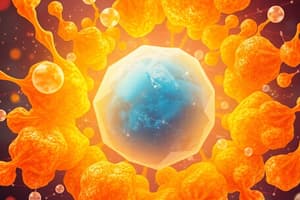Podcast
Questions and Answers
What elements are carbohydrates composed of?
What elements are carbohydrates composed of?
- Carbon, hydrogen, oxygen, and nitrogen
- Sodium, potassium, and chlorine
- Iron, calcium, and zinc
- Carbon, hydrogen, and oxygen (correct)
Which of the following is a common characteristic of disaccharides?
Which of the following is a common characteristic of disaccharides?
- They are composed of two monosaccharide units. (correct)
- They are the simplest form of carbohydrates.
- They cannot be broken down into smaller units.
- They consist of more than two sugar units.
What is the primary role of carbohydrates like starch and glycogen?
What is the primary role of carbohydrates like starch and glycogen?
- Genetic information storage
- Long-term energy storage (correct)
- Structural support in cells
- Enzyme catalysis
If a carbohydrate molecule cannot be broken down into smaller carbohydrates, how is it classified?
If a carbohydrate molecule cannot be broken down into smaller carbohydrates, how is it classified?
What reaction is required to bind two monosaccharides together to form a disaccharide?
What reaction is required to bind two monosaccharides together to form a disaccharide?
Which polysaccharide is the primary storage form of glucose in animals and is more branched than starch?
Which polysaccharide is the primary storage form of glucose in animals and is more branched than starch?
What is the primary function of dietary fiber, an indigestible carbohydrate?
What is the primary function of dietary fiber, an indigestible carbohydrate?
In the context of carbohydrate digestion, what determines the rate at which blood sugar levels rise?
In the context of carbohydrate digestion, what determines the rate at which blood sugar levels rise?
Which of the following statements best describes the role of ribose in biological systems?
Which of the following statements best describes the role of ribose in biological systems?
How are polysaccharides broken down in the body?
How are polysaccharides broken down in the body?
What is the key difference between glycolysis as an energy-producing method and other metabolic pathways?
What is the key difference between glycolysis as an energy-producing method and other metabolic pathways?
What process links monosaccharides to form larger carbohydrates and what type of bond is formed?
What process links monosaccharides to form larger carbohydrates and what type of bond is formed?
What effect do processed foods generally have on carbohydrate intake, compared to unrefined foods?
What effect do processed foods generally have on carbohydrate intake, compared to unrefined foods?
What role do monosaccharides play in more complex carbohydrate structures?
What role do monosaccharides play in more complex carbohydrate structures?
How does consuming carbohydrates affect the immune system, fertilization, and overall development?
How does consuming carbohydrates affect the immune system, fertilization, and overall development?
What primarily determines the classification of a carbohydrate as either simple or complex?
What primarily determines the classification of a carbohydrate as either simple or complex?
How does the structure of glycogen facilitate its role in providing energy to moving animals?
How does the structure of glycogen facilitate its role in providing energy to moving animals?
What is the role of enzymes such as glycoside hydrolase in carbohydrate metabolism?
What is the role of enzymes such as glycoside hydrolase in carbohydrate metabolism?
What is the chemical formula for disaccharides?
What is the chemical formula for disaccharides?
Where in the body is fructose broken down?
Where in the body is fructose broken down?
What are glucose and fructose classified as?
What are glucose and fructose classified as?
Which disaccharide is composed of D-galactose and D-glucose?
Which disaccharide is composed of D-galactose and D-glucose?
What type of bond links two monosaccharides to form a disaccharide?
What type of bond links two monosaccharides to form a disaccharide?
How many calories per gram does the body yield from carbohydrates?
How many calories per gram does the body yield from carbohydrates?
Which process happens when the body is in Glycolysis?
Which process happens when the body is in Glycolysis?
What high-energy compounds are formed from Glucose during glycolysis?
What high-energy compounds are formed from Glucose during glycolysis?
What is a primary health risk associated with a high sugar diet?
What is a primary health risk associated with a high sugar diet?
Why is identifying natural and added sugars important for the body?
Why is identifying natural and added sugars important for the body?
Why can't dietary fiber be used as an energy source?
Why can't dietary fiber be used as an energy source?
Flashcards
Carbohydrate
Carbohydrate
Essential molecule in the body, consisting of C, H, and O atoms. Includes sugars, starch, and cellulose.
Monosaccharides
Monosaccharides
Simplest carbohydrates that cannot be broken down further. General formula is (C•H₂O)n.
Disaccharides
Disaccharides
Formed when two monosaccharides join together, e.g., sucrose and lactose. Formula: C12H22O11.
Polysaccharides
Polysaccharides
Signup and view all the flashcards
Glucose in Nature
Glucose in Nature
Signup and view all the flashcards
Fructose
Fructose
Signup and view all the flashcards
Disaccharide Formation
Disaccharide Formation
Signup and view all the flashcards
Sucrose
Sucrose
Signup and view all the flashcards
Lactose
Lactose
Signup and view all the flashcards
Starch (in plants)
Starch (in plants)
Signup and view all the flashcards
Glycogen (in animals)
Glycogen (in animals)
Signup and view all the flashcards
Simple Carbohydrates
Simple Carbohydrates
Signup and view all the flashcards
Complex Carbohydrates
Complex Carbohydrates
Signup and view all the flashcards
Carbohydrate Digestion
Carbohydrate Digestion
Signup and view all the flashcards
Dietary Fiber
Dietary Fiber
Signup and view all the flashcards
Glycolysis
Glycolysis
Signup and view all the flashcards
High Sugar Diet Risks
High Sugar Diet Risks
Signup and view all the flashcards
Study Notes
- Carbohydrates is an essential molecule in the body, consisting of C, H, and O atoms.
- Carbohydrates are also called saccharides and include sugars, starch, and cellulose.
- Carbohydrates are divided into chemical groups based on increasing molecular weight (MW).
Carbohydrate Chemical Groups
- Monosaccharides consist of 1 unit, with names ending in "...ose".
- Disaccharides consist of 2 units, with names ending in "...ose".
- Polysaccharides consist of more than 2 units.
Classification of Carbohydrates
- Monosaccharides - Glucose, Fructose, Galactose
- Disaccharides - Maltose, Sucrose, Lactose
- Polysaccharides - Starch, Glycogen, Cellulose
Monosaccharides
- They are the simplest carbohydrates and cannot be broken down into smaller carbohydrates.
- The general chemical formula is (C•H₂O)n.
- Monosaccharides with three carbon atoms are called triose.
- Monosaccharides with four carbon atoms are called tetrose.
- Monosaccharides with five carbon atoms are called pentose.
- Functions as fuel molecules and building blocks for nucleic acids.
- Common examples include glucose and fructose.
- Link together to form polysaccharides.
Monosaccharides in Nature
- They are a major source of fuel for cellular metabolism.
- Glucose is the most important monosaccharide in nature.
- In plants, the equivalent to glycogen is stratch.
- In animals, glucose is stored in a space-efficient form called polysaccharide (glycogen, in humans and animals).
- Glycogen is stored in the liver and muscle cells.
- Fructose is found in fruit sugar, plants, and humans.
- Fructose is metabolized in the liver and absorbed directly into the intestines during digestion.
Disaccharides
- Formed when two monosaccharides join together, such as sucrose and lactose.
- They are composed of two monosaccharide units bound together by a covalent (glycosidic link) formed from a dehydration reaction (loss of H2O).
- There is a loss of a hydrogen atom from one monosaccharide and a hydroxyl group from the other when formed.
- Disaccharides have the chemical formula C12H22O11.
Disaccharides - Sucrose
- It is the most abundant disaccharide.
- Found in plants.
- Sucrose is composed of D-glucose and D-fructose.
- The bond between them is a glycosidic bond.
Disaccharides - Lactose
- It is composed of D-galactose and D-glucose.
- Sourced from Mammalian milk.
- Maltose is also another disaccharide.
Polysaccharides
- Polymeric long chains of monosaccharide units linked by glycosidic bonds.
- Can undergo hydrolysis to yield constituent monosaccharides.
- Can be linear or highly branched.
- They function in storage, such as starch and glycogen.
- They function in cellulose and chitin structure
Functions of Carbohydrates
- Polysaccharides store energy, such as starch and glycogen.
- Polysaccharides act as structural components in cells, such as cellulose in plants.
- Ribose, a 5-carbon monosaccharide, is important in genetic molecules (RNA and DNA).
- Saccharides are important for the immune system, fertilization, preventing disease, blood clotting, and foetal development.
Polysaccharides - Plants
- Starch is a polymer of glucose used as a storage molecule in plants.
Polysaccharides - Animals
- Glycogen is a more densely branched form of animal starch.
- Glycogen's properties allow it to be metabolized more quickly.
- Essential in the active lives of moving animals.
Classification of Carbohydrates
- Carbohydrates are classified as simple or complex.
- Simple carbohydrates (fructose) can raise blood glucose rapidly.
- Complex carbohydrates (starches) can raise blood sugar slowly.
- The Speed of digestion is determined by what else is consumed with the carbohydrate, how the food is prepared, inter-individual differences in metabolism, and the chemistry of the carbohydrate.
Carbohydrates and Nutrition
- Yield 3.87 calories of energy per gram of food, compared to fat at 9 calories per gram.
- Major metabolic pathways of monosaccharide catabolism are glycolysis and the citric acid cycle.
- In glycolysis, polysaccharides are cleaved into smaller monosaccharides by enzymes (glycoside hydrolase).
- Processed foods are associated with high levels of carbohydrates (sugars ie, biscuits).
- Unrefined foods have lower amounts of carbs and are associated with natural occurring foods ( i.e. vegetables).
- Dietary fiber (indigestible carbohydrates not changed), is not a source of energy.
- Dietary fiber functions to maintain a healthy digestive system.
- Inadequate fiber leads to significant increases in mortality, like bowel cancer.
Nutrition - Sugar
- Increased intake of sugar is associated with heart disease, type 2 diabetes, and some types of cancer.
- Natural sugars are not linked to health risks and also support fiber intake, vitamins, and minerals.
- Added sugars are the ones to limit.
- Reduced sugar intake is associated with improvements to weight and blood glucose levels.
- Food manufacturers and food labeling should support more informed choices for consumers.
- The recommended daily allowance (RDA) for adults is 30g of added sugar per day.
Glycolysis
- A metabolic pathway converts glucose (C6H12O6) into pyruvate (three carbon) (CH3COCOO− + H+).
- The energy released forms high-energy compounds: ATP and NADH.
- Glycolysis is a method that cells use to produce energy.
- It is carried out by 10 enzyme-based catalyzed reactions.
- Most monosaccharides (fructose and galactose) can be converted to one intermediate molecules.
- The intermediate molecules are used to form fatty acids.
- Fatty acids join to form fat.
Glycolysis location
- Occurs in most organisms in the cytosol (cytoplasm) of the cell.
- It is an oxygen-independent metabolic pathway.
- Does not use molecular oxygen which makes it an anaerobic process.
- Glycolysis is one of the most ancient metabolic pathways found in nature.
- The pathway is separated into two phases:
- The energy required phase, so called investment phase which consumes ATP.
- The energy releasing phase, in which ATP is produced.
Summary of Carbohdrates
- Different types (Classification) : Monosaccharides, disaccharides and polysaccharides.
- Roles and examples of each classification of carbohydrates.
- Simple vs complex carbohydrates
- Recommended daily allowance
- Benefits of a low sugar diet?
- Digestion of carbohydrates
- Process of Glycolysis
Studying That Suits You
Use AI to generate personalized quizzes and flashcards to suit your learning preferences.
Related Documents
Description
Explore the world of carbohydrates, essential molecules composed of C, H, and O atoms. Learn about their classification into monosaccharides, disaccharides, and polysaccharides based on molecular weight. Examples of each class are also provided.




